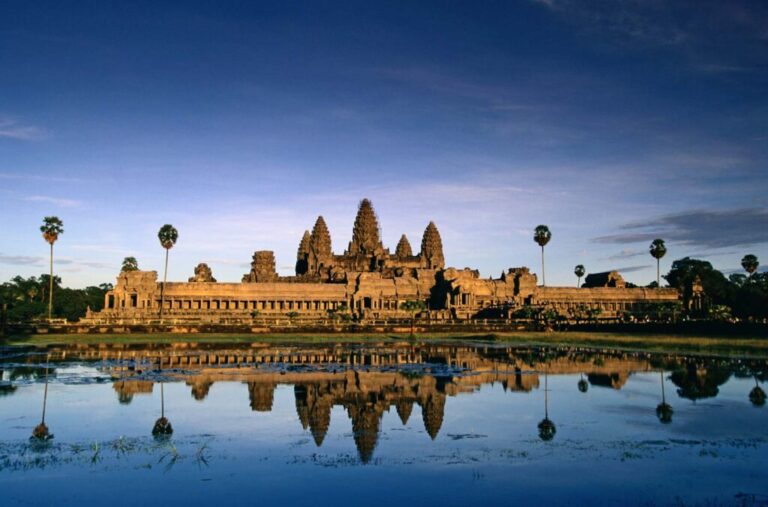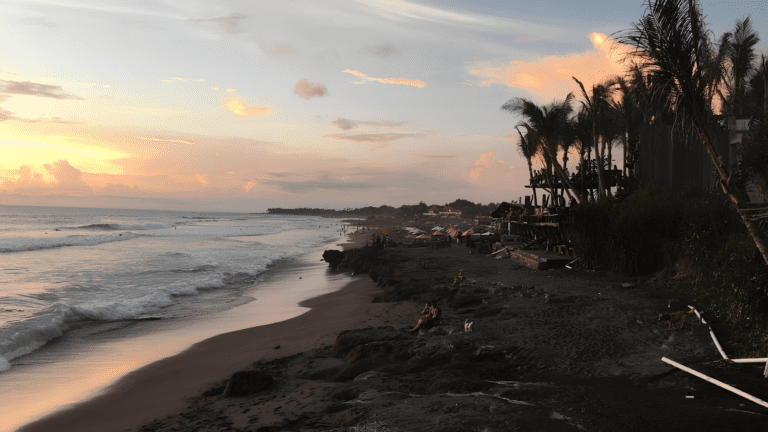Inle Lake Myanmar FULL TRAVEL GUIDE 2025 ( + Trekking)
Unveiling the Magic of Inle Lake – Your Ultimate Travel Guide
Hey there, fellow wanderlusters! It’s your girl, Zoe, from Funky Fresh Travels, coming at you with the hottest tips for exploring the enchanting Inle Lake in Myanmar’s beautiful Shan State. Buckle up, because we’re about to dive into a world of floating gardens, leg-rowing fishermen, and some of the most Instagram-worthy scenes you’ll ever lay eyes on!
Why Inle Lake Should Be on Your Bucket List

Let me tell you, folks, Inle Lake is not just another stop on your Southeast Asia itinerary – it’s a whole vibe! As Myanmar’s second largest lake, this freshwater paradise sits at a cool 2,900 feet above sea level, making it a refreshing escape from the hustle and bustle of city life. I’ve been lucky enough to call Nyaung Shwe (the main town near Inle Lake) my home away from home for the past few months, and let me tell you, it’s been nothing short of magical.
From the moment I arrived, I knew I was in for something special. The local people here are some of the warmest, most welcoming folks I’ve ever met, and the Intha people (the main ethnic group in the area) have a way of life that’ll blow your mind!
Inle Lake: A Gem of Myanmar’s Shan State
Nestled in the heart of Myanmar’s Shan State, Inle Lake stands as a testament to nature’s beauty and human ingenuity. This freshwater marvel, the second-largest lake in Myanmar, offers a unique blend of ecological wonder, cultural richness, and economic significance. Let’s dive into the most fascinating aspects of this enchanting destination.
A Geographical Marvel
Inle Lake covers an impressive area of approximately 116 square kilometers (44.9 square miles), making it a dominant feature of the region. Situated at an elevation of 880 to 900 meters (2,900 to 2,953 feet) above sea level, the lake’s highland location contributes to its distinctive climate and ecosystem . Despite its size, Inle Lake is surprisingly shallow, with an average depth of just 1.52 meters and a maximum depth of 3.7 meters.
Biodiversity Hotspot
The lake’s ecosystem is a treasure trove of biodiversity. It hosts over 35 native fish species, of which 17 are endemic, and about 45 species of freshwater snails, with 30 being unique to the lake . This rich biodiversity led to Inle Lake’s designation as a UNESCO World Biosphere Reserve in 2015, highlighting its ecological importance.

Cultural Tapestry
The Inle Lake region is home to approximately 200,000 people, with the Intha people being the predominant ethnic group . The Intha are renowned for their unique leg-rowing technique, a practical solution for navigating the lake’s waters while keeping their hands free for fishing. This distinctive method has become not just a practical skill but a cultural symbol of the region.

Economic Powerhouse
Inle Lake is a vital economic center, blending traditional industries with modern tourism. The lake attracts around 200,000 international visitors annually, alongside approximately one million local tourists, making it the second most visited tourist site in Myanmar after Bagan. This tourism boom has led to significant infrastructure development, including the construction of five-star hotels.
Agricultural Innovation
The Intha people have developed an ingenious method of agriculture – floating gardens. These gardens, constructed from clusters of water hyacinth roots and other plants, are anchored to the lakebed with bamboo poles . This innovative technique, which began in the 19th century, allows for the cultivation of various crops, most notably tomatoes, which are famous throughout Myanmar.
Environmental Challenges
Despite its beauty and importance, Inle Lake faces significant environmental challenges. From 1935 to 2000, the lake’s open water surface area decreased by 32.4%, primarily due to the expansion of floating gardens and sedimentation from surrounding hills . The introduction of non-native species and pollution from increased tourism and agriculture further threaten the lake’s delicate ecosystem.
Conservation Efforts
In response to these challenges, various conservation initiatives have been launched. The Fish for Livelihoods (F4L) project aims to improve local fisherfolk’s livelihoods by promoting sustainable fishing practices and diversifying income sources . These efforts are crucial for preserving the lake’s unique ecosystem and the traditional way of life it supports.
Cultural Celebrations
The Phaung Daw U Pagoda Festival, an 18-day event featuring the procession of revered Buddha images around the lake, traditional boat races, and vibrant celebrations, is one of the most significant cultural events at Inle Lake. This festival attracts both locals and tourists, showcasing the rich cultural heritage of the region.
Looking Ahead
As Inle Lake continues to evolve, balancing economic development with environmental conservation remains a critical challenge. The projected increase in annual tourist numbers to 500,000 in the near future underscores the need for sustainable tourism practices . The ongoing efforts to preserve the lake’s ecological and cultural integrity will be crucial in ensuring that this unique destination continues to thrive for generations to come.Inle Lake, with its floating gardens, leg-rowing fishermen, and rich biodiversity, remains a symbol of Myanmar’s natural beauty and cultural diversity. As it faces the challenges of the 21st century, the lake stands as a testament to the delicate balance between human ingenuity and nature’s resilience.
Getting There: Your Journey to Paradise
Nearest Airport and Transportation
Alright, let’s talk logistics. The closest airport to Inle Lake is Heho Airport, about 28 miles away from Nyaung Shwe. Now, I know what you’re thinking – “Zoe, that sounds like a hassle!” But trust me, it’s all part of the adventure! From Heho, you’ve got a few options to reach Inle Lake:

1. Shared taxi: This is what I did, and it was a blast! You’ll share the ride with other travelers, which is perfect for making new friends and splitting costs.

2. Private taxi: If you’re feeling fancy, go for it! It’s pricier but more comfortable.

3. Bus: For my budget travelers out there, this is your best bet. It’s cheap and cheerful, but be prepared for a bumpy ride!
Pro tip: If you’re coming from Yangon or Mandalay, consider taking an overnight bus. Yeah, it’s a long journey, but you’ll save on a night’s accommodation, and there’s something oddly romantic about waking up to the misty mountains of Shan State.
Best Time to Visit: Timing is Everything!
Listen up, because this is crucial! The best time to visit Inle Lake is during the dry season, which runs from November to February. I rolled into town in early December, and let me tell you, it was perfect! The weather was cool, the skies were clear, and the water level was just right for all those epic boat trips.
But here’s the thing – this is also high season, so expect more tourists and higher prices. If you’re looking to avoid the crowds and don’t mind a little heat, March to May can be a great alternative. Just be prepared to sweat it out a bit! Avoid the rainy season (June to October) if you can. The water level gets super high, and some activities might be limited. Plus, who wants to be stuck inside when there’s so much to explore?
Where to Stay: Nyaung Shwe vs. On the Lake
Okay, so you’ve made it to Inle Lake – now where do you crash? You’ve got two main options:
1. Nyaung Shwe: This is the main town and where I’ve set up camp. It’s bustling with local markets, restaurants, and tour agencies. Plus, it’s super convenient for organizing boat trips and other activities.

2. On the Lake: For a more unique experience, you can stay in one of the stilt hotels right on the water. It’s pricier, but waking up to those misty lake views? Priceless!

I’ve stayed in both, and honestly, you can’t go wrong either way. If you’re a social butterfly like me, Nyaung Shwe might be more your speed. But if you’re after that serene, one-with-nature vibe, staying on the lake is the way to go.
Must-Do Activities: Let’s Get This Party Started!
1. Inle Lake Boat Tour: The Ultimate Adventure
Alright, listen up because this is non-negotiable – you HAVE to do an Inle Lake boat tour! It’s the best way to experience the magic of this place, and trust me, you’ll be talking about it for years to come.I’ve done this tour more times than I can count (perks of living here, baby!), and it never gets old.
Here’s what you can expect:
Early morning start: Yeah, I know, getting up at the crack of dawn isn’t everyone’s cup of tea. But trust your girl Zoe on this one – it’s worth it! The lake is at its most beautiful in the soft morning light, and you’ll get to see the local fishermen in action.
Intha fishermen: These guys are the real stars of the show. They have this unique technique where they row with one leg wrapped around a bamboo pole. It’s like watching a ballet on water – absolutely mesmerizing!
Floating gardens: Ever seen a garden that floats? Well, now you will! The Intha people have mastered the art of growing vegetables on floating islands made of water hyacinth and mud. It’s ingenious and makes for some killer photos.
Floating villages: You’ll cruise through villages built entirely on stilts. It’s like something out of a fantasy novel!
Local markets: Depending on the day, you might stop at one of the rotating floating markets. It’s a riot of colors, smells, and sounds – a feast for all your senses!
Pro tip: Make friends with your boat driver. These guys know all the best spots and can take you off the beaten path if you ask nicely. Plus, they’ve got some wild stories to tell!
2. Phaung Daw Oo Pagoda: A Spiritual Journey

No trip to Inle Lake is complete without a visit to the Phaung Daw Oo Pagoda. It’s usually the first stop on most boat tours, and let me tell you, it’s a sight to behold!The pagoda houses five small Buddha images, which have been covered in so much gold leaf over the years that they now look like golden blobs. It might sound weird, but trust me, it’s pretty awe-inspiring.When I visited, there was a group of young monks chanting, and the whole atmosphere was just… magical. Even if you’re not religious, the peace and tranquility of this place will touch your soul.
3. Nga Phe Kyaung Monastery: The Jumping Cat Monastery

Okay, full disclosure – the cats don’t actually jump anymore. But this wooden monastery, also known as the “Jumping Cat Monastery,” is still worth a visit.Built on stilts over the lake, this monastery is home to a collection of ancient Buddha statues.
But the real draw? The resident cats that lounge around like they own the place (which, let’s be real, they probably do).I spent a good hour here just chilling with the cats and chatting with the friendly monks. It’s a great place to take a breather and soak in the peaceful vibes.
4. Indein Village and Shwe Indein Pagoda: Indiana Jones Vibes

Hold onto your hats, adventure seekers, because Indein Village is about to blow your mind! This place feels like a set from an Indiana Jones movie, with hundreds of ancient stupas in various states of decay and restoration.The boat ride to Indein is an adventure in itself. You’ll cruise down a narrow canal, ducking under low-hanging bridges and passing by local villages. It’s like a jungle cruise, but way cooler!
Once you reach the village, take a short walk up the covered stairway to the Shwe Indein Pagoda complex. The view from the top is absolutely breathtaking – rolling hills, the lake in the distance, and hundreds of stupas as far as the eye can see.I spent hours exploring this place, imagining what it must have looked like in its heyday. It’s a photographer’s dream, especially during golden hour!
5. Red Mountain Estate Vineyards: Wine Not?

Who says you can’t get good wine in Southeast Asia? Red Mountain Estate Vineyards is here to prove that notion wrong! Located on a small hill just outside Nyaung Shwe, this winery offers stunning views of the surrounding area. I cycled here one afternoon
pro tip: rent a bike in Nyaung Shwe, it’s the best way to explore the area), and it was one of the highlights of my trip.For a small fee, you can do a wine tasting of their reds and whites. My personal favorite? Their Sauvignon Blanc – crisp, refreshing, and perfect for those balmy Shan State evenings.
The best part? Watching the sunset over Inle Lake with a glass of local wine in hand. It doesn’t get much better than that, folks!
Off the Beaten Path: Hidden Gems
1. Inle Lake Trek: For the Adventure Seekers
If you’re up for a real adventure (and trust me, you should be), consider doing the 3-day trek from Kalaw to Inle Lake. It’s not for the faint of heart, but it’s an experience you’ll never forget.I did this trek with a group of fellow travelers I met in Nyaung Shwe, and it was hands down one of the best experiences of my life.

You’ll trek through stunning landscapes, stay with local families in small villages, and get a glimpse into rural life in Myanmar. The trek ends with you arriving at Inle Lake by boat, which is pretty much the most epic entrance you could ask for.
2. Hot Springs: Soak Your Worries Away

After all that trekking and exploring, your body will be begging for some R&R. Enter the Khaung Daing hot springs, located on the west side of the lake.
These natural hot springs are the perfect place to soak your tired muscles and chat with locals. I spent a whole afternoon here, moving between the different pools and practicing my very limited Burmese with some friendly locals.
3. Cooking Class: Spice Up Your Life
Want to bring a taste of Inle Lake home with you? Sign up for a cooking class! I took one at a small restaurant in Nyaung Shwe, and it was a blast. We learned to make traditional Shan dishes like Shan-style rice (my new obsession) and tea leaf salad. The best part? You get to eat your creations afterward!
Practical Tips: The Nitty-Gritty
1. Money Matters

ATMs can be found in Nyaung Shwe, but they can be temperamental. I learned this the hard way when I tried to withdraw cash for a boat trip and ended up having to borrow money from my new trek buddies. Lesson learned – always have some backup cash!
2. Dress Code
Remember, Myanmar is a conservative country. When visiting religious sites like pagodas and monasteries, make sure to cover your shoulders and knees. I always carry a light scarf in my bag for this purpose.
3. Sunscreen is Your Best Friend
The sun can be intense out on the lake, even on cloudy days. Trust me, you do not want to end up looking like a lobster in all your vacation photos. Slather on that SPF, people!
4. Learn a Few Burmese Phrases
A little effort goes a long way. Learning to say “hello” (mingalabar) and “thank you” (cezu tinbade) in Burmese will earn you big smiles from the locals.
5. Respect the Environment
Inle Lake is a fragile ecosystem. Do your part by not littering, using reusable water bottles, and supporting eco-friendly businesses.
Trekking Inle Lake Myanmar: All That You Have to Know
Hey there, adventure seekers! It’s Zoe from Funky Fresh Travels, back with another epic guide. Today, we’re diving deep into the world of trekking around Inle Lake, Myanmar. Trust me, this is one experience you don’t want to miss!
Why Trek Inle Lake?
Before we get into the nitty-gritty, let’s talk about why you should even consider trekking in this area. Inle Lake isn’t just about boat trips and floating gardens (although those are awesome too). The surrounding hills and villages offer a whole new perspective on this magical region

Trekking here gives you the chance to:
- Experience the authentic local life of various ethnic groups
- Witness breathtaking landscapes that you can’t see from the lake
- Challenge yourself physically while immersing in nature
- Support local communities through homestays and guides
Best Time for Trekking
Timing is everything when it comes to trekking Inle Lake. The best time to lace up those hiking boots is during the dry season, which runs from November to February. I did my trek in early December, and let me tell you, it was perfect!

During these months, you can expect:
- Cool, comfortable temperatures (especially in the mornings and evenings)
- Clear skies for those Instagram-worthy views
- Dry trails that are easier to navigate
If you’re on a budget or prefer fewer crowds, consider the shoulder seasons of October and March. Just be prepared for a bit more heat and possibly some muddy trails. Avoid the rainy season (June to September) if possible. The trails can become slippery and dangerous, and leeches become a real nuisance. Plus, those stunning views might be obscured by clouds and mist.
Popular Trekking Routes
1. Kalaw to Inle Lake Trek
This is the granddaddy of all treks in the area, and it’s the one I did. It’s a 3-day, 2-night journey that takes you from the hill station of Kalaw to Inle Lake. Here’s a quick breakdown:
Day 1: Start in Kalaw, trek through pine forests and tea plantations
Day 2: Pass through various ethnic minority villages, learning about local customs
Day 3: Descend towards Inle Lake, ending with a boat ride to Nyaung Shwe
The total distance is about 60 km (37 miles), but don’t let that scare you. It’s mostly gentle terrain with a few challenging uphill sections.
2. Pindaya to Inle Lake Trek
For those looking for a shorter option, the Pindaya to Inle Lake trek is a great alternative. It’s typically done in 2 days and offers:
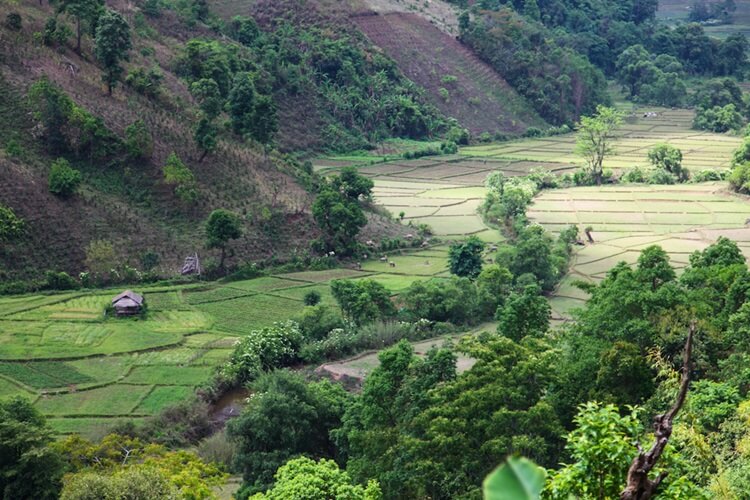
Stunning views of the Pindaya caves
Visits to Danu and Pa-O villages
A more off-the-beaten-path experience
3. Day Treks from Nyaung Shwe
If you’re short on time or not up for a multi-day trek, there are plenty of day trek options from Nyaung Shwe. These usually involve:

Hiking to nearby villages like Mine Thauk or Indein
Exploring the eastern or western shores of the lake
Combining short hikes with boat trips for a varied experience
What to Expect on the Trek
Alright, let’s get down to the details. What’s it really like to trek around Inle Lake?
Terrain and Difficulty
The terrain varies from easy flat sections to moderate uphill climbs. Most of the popular routes are well-trodden and don’t require technical hiking skills. However, a decent level of fitness is recommended, especially for the multi-day treks.You’ll be walking on:
Dirt paths through farmland
Forest trails
Some paved roads between villages
Accommodation
One of the coolest parts of trekking here is the opportunity to stay in local villages. On my Kalaw to Inle Lake trek, we spent nights in:
A monastery (an unforgettable experience!)
A local family’s home
Expect basic accommodations – usually mattresses on the floor with mosquito nets. It’s not luxury, but it’s authentic and comfortable enough.
Food
Get ready for some delicious local cuisine! Most treks include meals, and they’re usually a highlight. You might enjoy:
Traditional Shan noodles

Fresh vegetables from local gardens
Hearty soups perfect for refueling
Don’t forget to try the local tea at every opportunity – it’s amazing!
Cultural Experiences
The trek isn’t just about the physical journey; it’s a cultural immersion. You’ll have the chance to:
Learn about traditional farming methods
Participate in local crafts like weaving
Interact with people from various ethnic groups including Pao, Danu, and Intha
Preparing for Your Trek
Now that you’re pumped for this adventure, let’s talk preparation.
What to Pack?
Less is more when it comes to trekking, but there are some essentials:
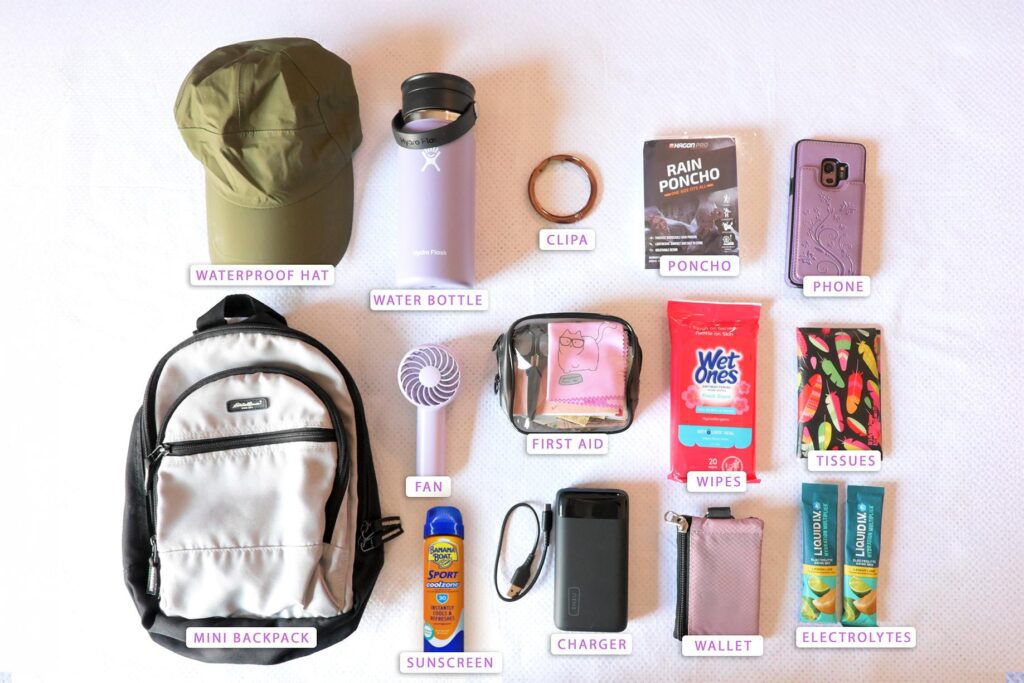
- Comfortable, broken-in hiking shoes
- Light, breathable clothing (layers are key!)
- Rain jacket (just in case)
- Sunscreen and a hat
- Reusable water bottle
- Camera (trust me, you’ll want it)
- Small backpack for daily essentials
- Most tour operators will transport your main luggage to your end destination, so you only need to carry a day pack.
Choosing a Guide
While it’s technically possible to trek independently, I highly recommend going with a guide.
They provide:
- Local knowledge and language skills
- Cultural insights you might miss on your own
- Safety and navigation expertise
Look for guides or trekking companies that:
- Are locally based and support the community
- Have good reviews and safety records
- Offer small group sizes for a more personal experience
Fitness Preparation
You don’t need to be an Olympic athlete, but some preparation will make your trek more enjoyable:
Start a walking routine a few weeks before your trip
Include some uphill walks to build stamina
Break in your hiking shoes to avoid blisters
Responsible Trekking
As always, it’s crucial to trek responsibly to preserve this beautiful area for future generations.
Environmental Considerations
Stick to marked trails to prevent erosion
Pack out all your trash (and pick up any you see along the way)
Use biodegradable soap and shampoo
Conserve water, especially in village homestays
Cultural Respect
Dress modestly, especially when visiting religious sites
Ask permission before taking photos of people
Learn a few basic phrases in the local language
Be open to trying new foods and experiences
Supporting Local Communities
Buy snacks and water from local vendors along the route
Consider purchasing handmade souvenirs directly from artisans
Tip your guide and porters appropriately
Beyond the Trek: Extending Your Inle Lake Adventure
Once you’ve completed your trek, don’t rush off! Inle Lake has so much more to offer:
- Take a traditional boat tour of the lake
- Visit the local markets (the rotating 5-day market is a must)
- Explore the Red Mountain Estate Vineyards for some wine tasting
- Check out the Phaung Daw Oo Pagoda and other cultural sites
Final Thoughts
Trekking around Inle Lake is more than just a physical journey – it’s a voyage into the heart of Myanmar’s cultural landscape. From the moment you take your first step on those dirt paths to the final boat ride across the lake, you’ll be immersed in an experience that will stay with you long after you’ve returned home.
The stunning vistas, the warmth of the local people, the sense of accomplishment as you reach each new village – these are the things that make trekking here so special. It’s a chance to slow down, to really connect with a place and its people in a way that’s increasingly rare in our fast-paced world.
So, my fellow adventurers, I challenge you to step off the beaten path, to push your boundaries, and to discover the magic of Inle Lake on foot. Trust me, it’s an adventure you’ll be talking about for years to come.
Wrapping It Up: The Magic of Inle Lake
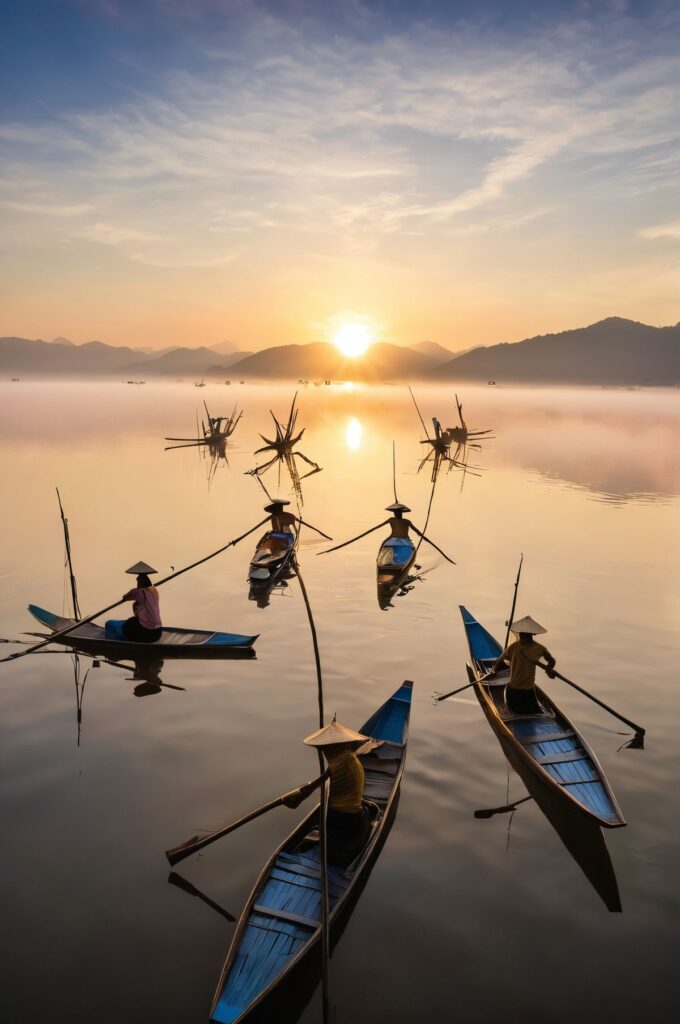
As I sit here on my little balcony in Nyaung Shwe, watching the sun set over the distant hills, I can’t help but feel incredibly grateful for the time I’ve spent at Inle Lake. This place has a way of getting under your skin, of making you fall in love with its serene beauty and the warmth of its people. From the gentle lapping of water against your boat as you cruise through floating gardens, to the rhythmic chanting of monks at dawn, to the laughter shared over a glass of local wine as the day comes to a close – Inle Lake is a feast for the senses and balm for the soul.
So, my fellow travelers, I implore you – don’t just pass through Inle Lake. Stay a while. Immerse yourself in the local life. Take that cooking class, chat with the fishermen, explore those dirt roads on a rickety bicycle.
Let the magic of this place seep into your bones. Because trust me, once you’ve experienced the wonder of Inle Lake, a little piece of your heart will always remain here, floating on its tranquil waters.Until next time, keep it funky and fresh!
WHO AM I ?
Hello! I’m Eric, a French Australian citizen based between Australia, Asia and Bali and I love to travel and experience the world. I generally like outdoor activities, wellness, great food and venues , party and real local adventures ! I am a Yoga practitioner and fitness lover
I created this blog because I love to travel and I want to share my experiences with others. I’ve been traveling since I was a child, and I’ve been to over 50 countries. I’ve seen some amazing things and met some amazing people, and I want to help others experience the same things.

I believe that travel is one of the best ways to learn about the world and about yourself. When you travel, you’re forced to step outside of your comfort zone and experience new things. You learn about different cultures, different religions, and different ways of life. You also learn about yourself, your strengths, and your weaknesses.
Travel can also be a great way to make new friends. When you’re traveling, you’re surrounded by people from all over the world, and you’re all in the same boat. You’re all there to explore and experience new things, and that can create a bond between people.
Let’s connect together!
I hope that my travel blog will inspire others to travel and to see the world. I also hope that it will help people to learn about different cultures and to become more open-minded.



![Things To Do In Varanasi + Ghats & Temples [ Travel 2025 ]](https://funkyfreshtravels.com/wp-content/uploads/2025/07/Benaras-3-768x496.jpg)
